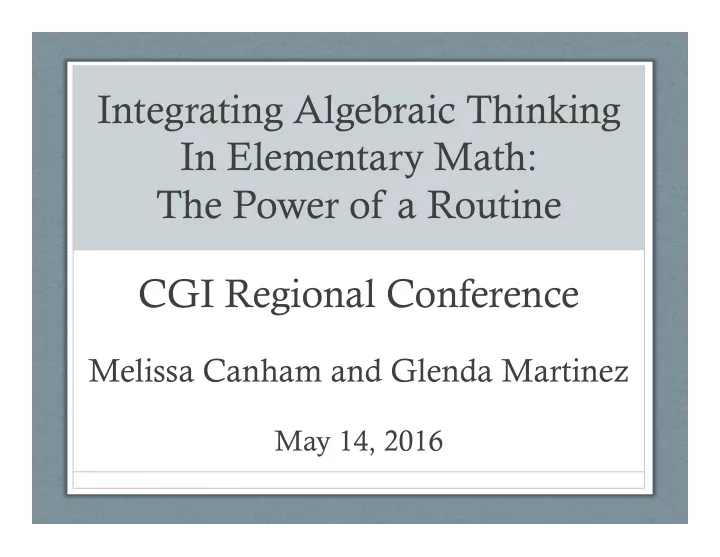

Integrating Algebraic Thinking In Elementary Math: The Power of a Routine CGI Regional Conference Melissa Canham and Glenda Martinez May 14, 2016
What is Algebraic Thinking? Algebraic thinking involves the construction and representation of patterns and regularities, deliberate generalization, and most important, active exploration and conjecture. (Kaput, NCTM, 1993).
“Children can learn arithmetic in a way that provides a basis for learning algebra.” Thinking Mathematically, Carpenter, Franke, & Levi
What does Algebraic Thinking look like in Elementary CCSS-M? • “Using objects or drawings” • “Use strategies such as…” • “Strategies based on place value, properties of operations, and the relationship between…” • “Flexible thinking”
Relational Thinking • Students are able to express a number in terms of other numbers and operations on those numbers • Takes into account the fundamental properties of operations and equality • The equal sign is viewed as expressing a relation between numbers
The Standards for Mathematical Practice 1. Make sense of problems and persevere in solving them. 2. Reason abstractly and quantitatively. 3. Construct viable arguments and critique the reasoning of others. 4. Model with mathematics. 5. Use appropriate tools strategically. 6. Attend to precision 7. Look for and make use of structure 8. Look for and express regularity in repeated reasoning.
What is a Routine? • 5 – 15 minutes during the opening of math time • Provide students with meaningful ongoing practice with: • Number Sense • Place Value • Computational Fluency • Properties of Operations • Fractions • Standards for Mathematical Practice • Listening to others’ strategies
Routines • Allows teachers to fill in the number sense holes that students are coming in with • Helps to introduce new strategies in a way that gets students thinking • Forces students (especially older students) to think outside the standard algorithm • Helps to emphasize the Standards for Mathematical Practice • Helps to address the fluency standard
Goals for Making Properties of Arithmetic Explicit • All students have access to basic mathematical properties • Students understand why the computation procedures they use work the way they do • Students apply their procedures flexibly in a variety of contexts • Students recognize the connections between arithmetic and algebra and can use their understanding of arithmetic as a foundation for learning algebra with understanding - Thinking Mathematically, Carpenter et. al
True/False Number Sentences
CGI Approach to Problem Solving When problems are sequenced in ways that are sensitive to children’s developing understanding, children can solve both word problems and equations without explicit instruction.
True/ False Number Sentences 2 x 5 = 5 + 5 2 + 2 + 2 + 2 + 2 = 2 x 5 5 x 2 = 2 x 5 3 x 5 x 2 = 10 x 3 2 x 12 = 2 x 6 x 6
“The primary goal in giving students these number sentences is not to teach students efficient ways to solve algebra equations; it is to engage them in thinking flexibly about number operations.” - Thinking Mathematically, Carpenter et. al, pg. 73
True/False Number Sentences
What Did You Notice? • What algebraic thinking was evident? • How did the teacher respond? • If these were your students, where would you go next with these ideas?
Quick Images
How Many Dots?
Quick Images
What Did You Notice? • What algebraic thinking did students have? • How did the teacher respond? • If these were your students, where would you go next with these ideas?
Quick Images
What Did You Notice? • What algebraic thinking did students have? • How did the teacher respond? • If these were your students, where would you go next with these ideas?
“We are not proposing that it is always necessary to introduce equations or use names of properties with children. What is important is that children meaningfully engage with these properties and that they begin to explicitly recognize how the mathematics they are using depends on them.” - Children’s Mathematics, Carpenter et. al, pg.179
Open Expressions
For each expression below, choose two different values that would make calculations “easy”. Then simplify the expressions. 1 10 × ___ × 8 9 × ___ × 1 4 3 6 × ___ × 4
“Learning about whole numbers should provide a foundation for learning about fractions and decimals and it should involve a seamless transition to learning algebra.” - Children’s Mathematics, Carpenter et. al, pg. xx
Open Expressions
What Did You Notice? • What algebraic thinking did students have? • How did the teacher respond? • If these were your students, where would you go next with these ideas?
Open Expressions
What Did You Notice? • What algebraic thinking did students have? • How did the teacher respond? • If these were your students, where would you go next with these ideas?
Number of the Day
How Many Ways Can You Make… I will pose a number to you. For each number, find many ways to make that number. ◦ Ex: How Many Ways Can You Make 8? 3 + 5 = 8 2 + 2 + 2 + 2 = 8
Number of the Day 112 tally marks ten fames ten frames with 10s in the box instead of dots 112+0 0+112 one hundred twelve (10) 2 +12 (10) 2 +6+6 100+12 10X10+12 30+70+12 70+30+12 10+10+10+20+20+20+20+2 even (25X4)+12 28X4 1+1+1+1+1+1+1 all the way to 112 82+30 (50X2)+12 (400÷4)+12 200-80-8 113-1 112+0 200+200-300+12 50+50+10+2 108+4 120-8
Goals for Making Properties of Arithmetic Explicit • All students have access to basic mathematical properties • Students understand why the computation procedures they use work the way they do • Students apply their procedures flexibly in a variety of contexts • Students recognize the connections between arithmetic and algebra and can use their understanding of arithmetic as a foundation for learning algebra with understanding
Thank You! Melissa Canham: mcanham@dusd.net @Melissa_Canham Glenda Martinez: gmartinez@dusd.net @GCMartinez23 DUSD CGI Website: www.dusd.net/cgi
Recommend
More recommend